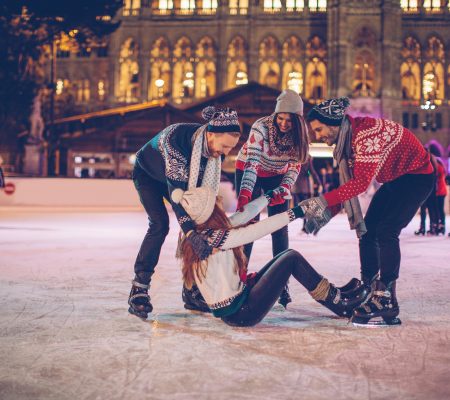Cold Weather Safety: How to Avoid Winter Slips and Falls
Dr. David Meister, Hand to Shoulder Specialists of Wisconsin
Winter is once again upon us! Here in Wisconsin, the coldest weather typically occurs in January and February. As we know all too well, cold temperatures lead to snow, sleet, and ice—increasing the likelihood of winter slips and falls.
Fortunately, you don’t need to spend the season hibernating indoors to avoid injury. There are plenty of ways to steer clear of these common winter weather hazards and keep yourself safe.
WINTER SLIPS AND FALLS: RISK FACTORS TO WATCH
A few preventative measures will help you stay safe, no matter the conditions outside. When you go outdoors, look out for the following cold weather risks that could cause slips and falls:
- Walk slowly and carefully on snow and ice-covered sidewalks.
- Keep an eye out for slippery floors inside and walkways outside due to melting snow and ice.
- Use handrails and other walking aids whenever available.
- Be cautious of black ice (which has the appearance of wet asphalt).
- Stay aware of your surroundings and tell someone where you’re going.
- Avoid carrying heavy items and walking with occupied hands. If your hands are in your pockets, it’s difficult to catch yourself should you slip or become off-balance.
- Steer clear of uneven surfaces—such as steps and curbs—whenever possible.
- Walk pets one-at-a-time, being mindful of the leash.

By watching out for these simple risk factors, you’ll avoid many of the most common causes of winter slips and falls. Should a fall occur, Orthopaedic Hospital of Wisconsin is here to help. Below, we’ve asked OHOW’s own Dr. David Meister to provide insight into some common upper extremity injuries (injuries to the arms and shoulders) and how they are treated.
ONE FALL, THAT’S ALL
Unfortunately, icy conditions increase the risk of upper extremity injuries secondary to falls. The process for diagnosing a patient who is experiencing pain after a fall typically includes x-rays to evaluate for a fracture or dislocation.
With winter falls, sometimes the injury is obvious, such as a displaced olecranon (elbow) or proximal humerus (shoulder) fracture. Other times, the upper extremity injury is subtle, such as a nondisplaced distal radius (wrist) fracture. On some occasions, we’ll see an occult fracture (a fracture which is present but doesn’t show up on initial X-ray), or a significant soft tissue injury such as a rotator cuff tear of the shoulder, caused by “catching” the weight of the body during a fall.
COMMON SLIP AND FALL INJURIES
One of the most common types of occult fractures is a scaphoid fracture (a fracture of the hand). If there is any suspicion of this type of fracture, we suggest a quick referral to a hand and wrist specialist.
Early treatment of a scaphoid fracture involves immobilization of the thumb using a spica splint and scheduling repeat radiography (x-rays) two weeks from the time of injury. An alternative option is to use advanced imaging such as a CT or MRI to determine the diagnosis earlier. This approach also allows us to determine if there are other soft tissue injuries such as a scapholunate ligament tear.
If patients neglect to treat scaphoid fractures and hand injuries for more than 4-6 weeks, it can make the eventual treatment more difficult. Often the injury may require operative treatment when a patient could otherwise have avoided surgery. The most important point is to never wait on a hand injury. Early treatment is always best.
In ground-level slips and falls, shoulders are another common joint injury. Rotator cuff tears are often due to overuse, but an acute traumatic event (such as an unfortunate slip on the ice) can also exacerbate the injury.
Symptoms of a shoulder injury include pain and swelling at the shoulder that often radiates down the arm. Treatment of this type of damage depends on both the condition and severity, but most patients get better with non-operative management. We often suggest a period of rest, anti-inflammatory medications such as ibuprofen, bracing, physical therapy, or corticosteroid injections.
For patients with more severe shoulder injuries, or those opposed to non-operative management, surgery can help alleviate pain and improve function. Surgery involves direct repair of a torn tendon and removal of inflamed tissue, allowing tendons to glide better. Rotator cuff and shoulder surgeries are often performed on an outpatient basis and may involve arthroscopic or mini-open techniques.
THE HEALING PROCESS
Never ignore injuries that occur from wintertime slips and falls. It is essential to be diligent about seeking treatment for upper extremity injuries, as they significantly affect your comfort as well as your ability to work and perform daily activities.
The first step in treating these types of injuries is performing a prompt and accurate diagnosis. Often, a patient with a hand fracture can be treated with non-operative measures such as a custom-molded cast or splint and therapy. When surgery is indicated, we take pride in our specialized methods that allow patients to rehabilitate as quickly as possible.
Surgery for upper extremity fractures is usually performed on an outpatient basis. In more involved cases, such as shoulder fractures that require plates and screws or a shoulder replacement, patients may need to stay overnight in the hospital.
One of the significant benefits to surgery is that once the fracture is stabilized, patients can often begin early range of motion rehabilitation protocols right away. It still takes 8-12 weeks for the fracture to heal, but at least it will heal in a normal anatomic position. The strengthening phase of rehabilitation progresses for 4-6 months, depending on the patient’s activity demands and the specific type of injury.
Despite the best preventive measures, slip and fall injuries can happen to anyone. Dr. Meister is always available to answer questions and is happy to see patients with any condition from shoulder to fingertip. If you find yourself in pain after a slip or fall in the winter, contact the Orthopaedic Hospital of Wisconsin at 414-916-6880. Be careful, and stay safe this winter season.


